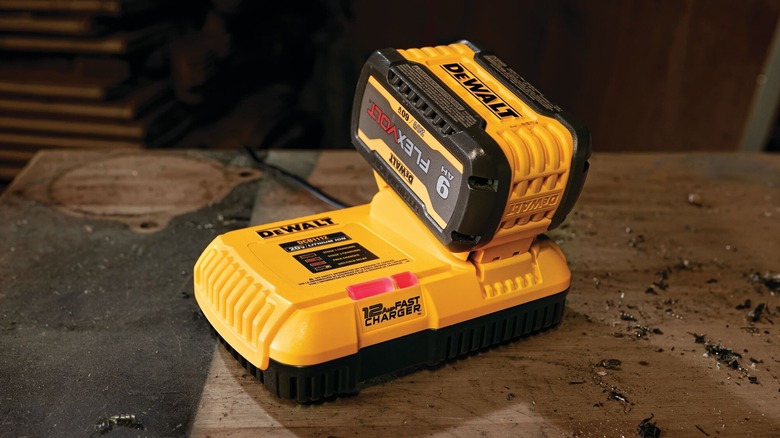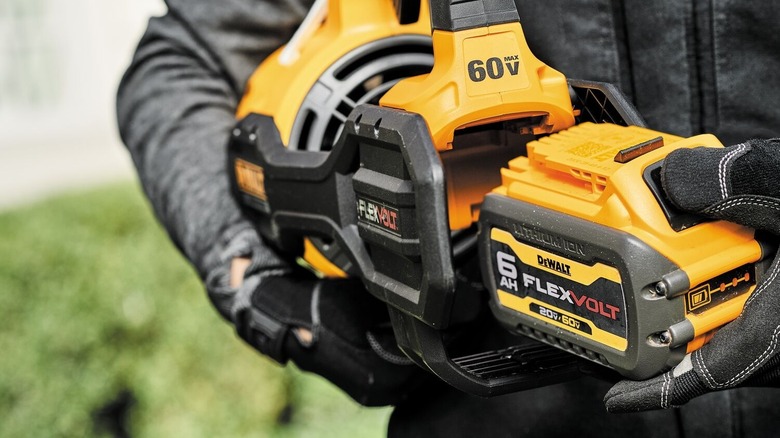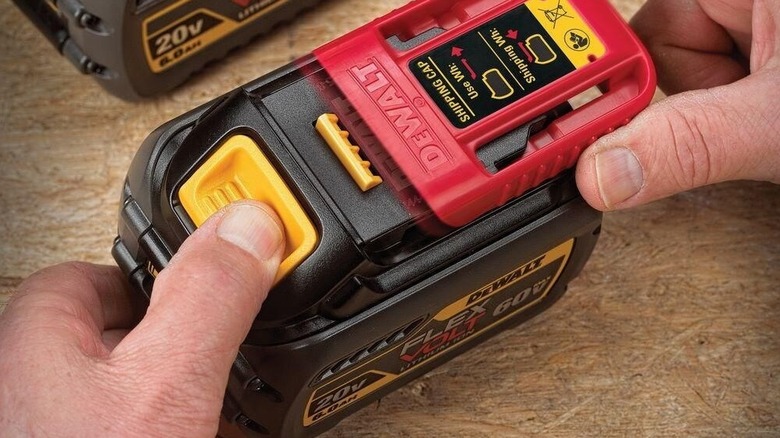Your DeWalt Flexvolt Battery Won't Hold A Charge? This Might Be Why
DeWalt's line of Flexvolt batteries makes it convenient to own both 20V and 60V tools. Instead of buying separate batteries for each one, you can simply use the DeWalt Flexvolt packs on the 20V tools just as easily as you can on the 60V. The battery will automatically switch based on what input voltage the equipment needs — no intervention required on your end.
But while the DeWalt Flexvolt batteries are indeed a practical addition to your tool collection, they can also be frustrating to use. One of the issues users typically encounter with Flexvolt is that the battery won't hold a charge. It either discharges more quickly than before or refuses to charge altogether. This typically results from improper storage of the battery or simply from poor contact between the contacts of the battery and the charger. If your DeWalt Flexvolt no longer holds a charge, here are some of the troubleshooting techniques you can apply.
Your battery and charger aren't making proper contact
If you recently bought a DeWalt Flexvolt battery, then you already know it isn't shipped fully charged. The problem, though, is that as soon as you slide it into a charger, the light indicators on your DeWalt charger immediately show a solid red. This means the pack is already at 100%, which is not actually the case. To fix this, all you have to do is push down on the release button on the front of the Flexvolt battery and hold it until the pack is securely connected to the charger contacts. You should now see a red light flashing, which indicates the battery is charging.
If your DeWalt Flexvolt isn't new and refuses to hold a charge, check whether the problem is with the charger or the battery. Try a different battery pack like a DeWalt 20V MAX XR. If that doesn't charge either, you might have a dirty charger, preventing the contacts from properly connecting with the battery.
Remove it from the wall outlet to avoid accidental shocks while cleaning. Then, use a piece of cloth and a non-metallic soft-bristled brush to wipe away the grime. Don't apply any sort of liquid, especially harsh cleaning solvents. If cleaning doesn't solve the issue, the charger might already be faulty. Reach out to DeWalt's customer service to check if they can repair or replace it. If your charger works, test your DeWalt Flexvolt battery in other compatible chargers. Try cleaning it with the same materials before reinserting it.
Other users online might suggest resetting the battery or disassembling it to repair it yourself. If you're not confident enough to do either, just take the battery to a service center for a professional checkup.
You didn't store the DeWalt Flexvolt batteries properly
If you just use your DeWalt Flexvolt batteries for occasional projects, chances are they stay in storage for weeks or even months. In that case, you might have unintentionally stored the batteries the wrong way, which could be the reason they no longer hold a charge. There are two primary factors that could've contributed to this.
The first is the temperature of the storage location. Ambient temperatures where you store your DeWalt Flexvolt batteries should stay below 104 °F (40 °C). Storing your power tool batteries in a hot car or garage could permanently damage the cells and lead to capacity loss. When your DeWalt Flexvolt batteries experience capacity loss, it means they can't store as much energy as they once did. For instance, they might only charge up to 60% instead of the previous 100%. You'll then notice that they'll run low sooner than you expect them to.
Another storage mistake that can lead to battery capacity loss is storing the battery with a low charge. Li-ion batteries have a self-discharge rate, which is a certain percentage of their capacity that they lose when not in use. This is typically about 1.5 to 2% per month. If you leave your DeWalt Flexvolt battery unused for over a year at just 10%, it will overdischarge. When it does, it might no longer charge again. That's why DeWalt recommends charging the batteries to 100% first before storing, especially for longer than six months.
Unfortunately, once your DeWalt Flexvolt battery stops holding a charge, the only thing left to do is to dispose of it — but not with your household waste. Used Li-ion batteries are a known fire hazard when damaged or defective. To be safe, bring the old DeWalt Flexvolt battery to a DeWalt service center instead.


